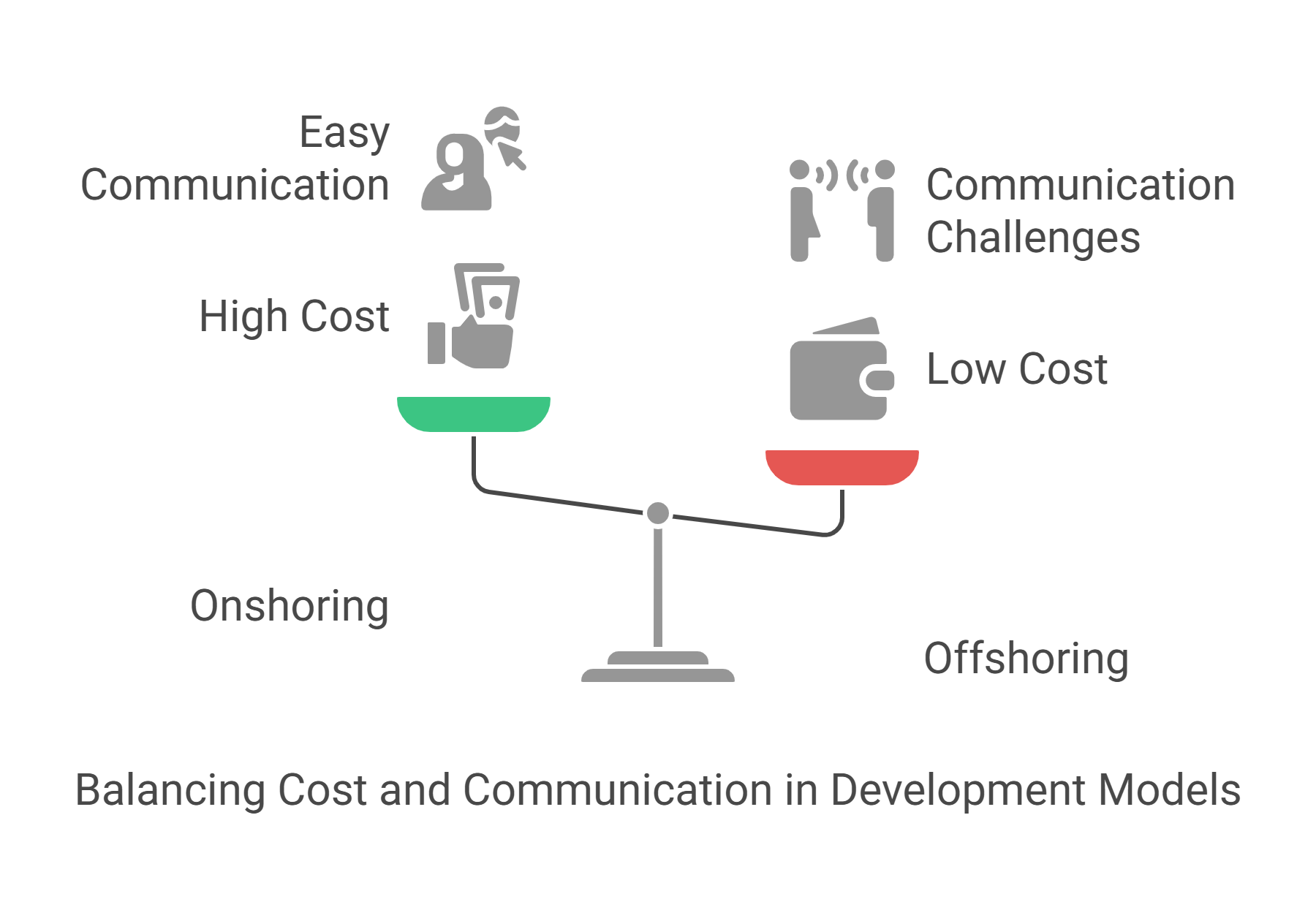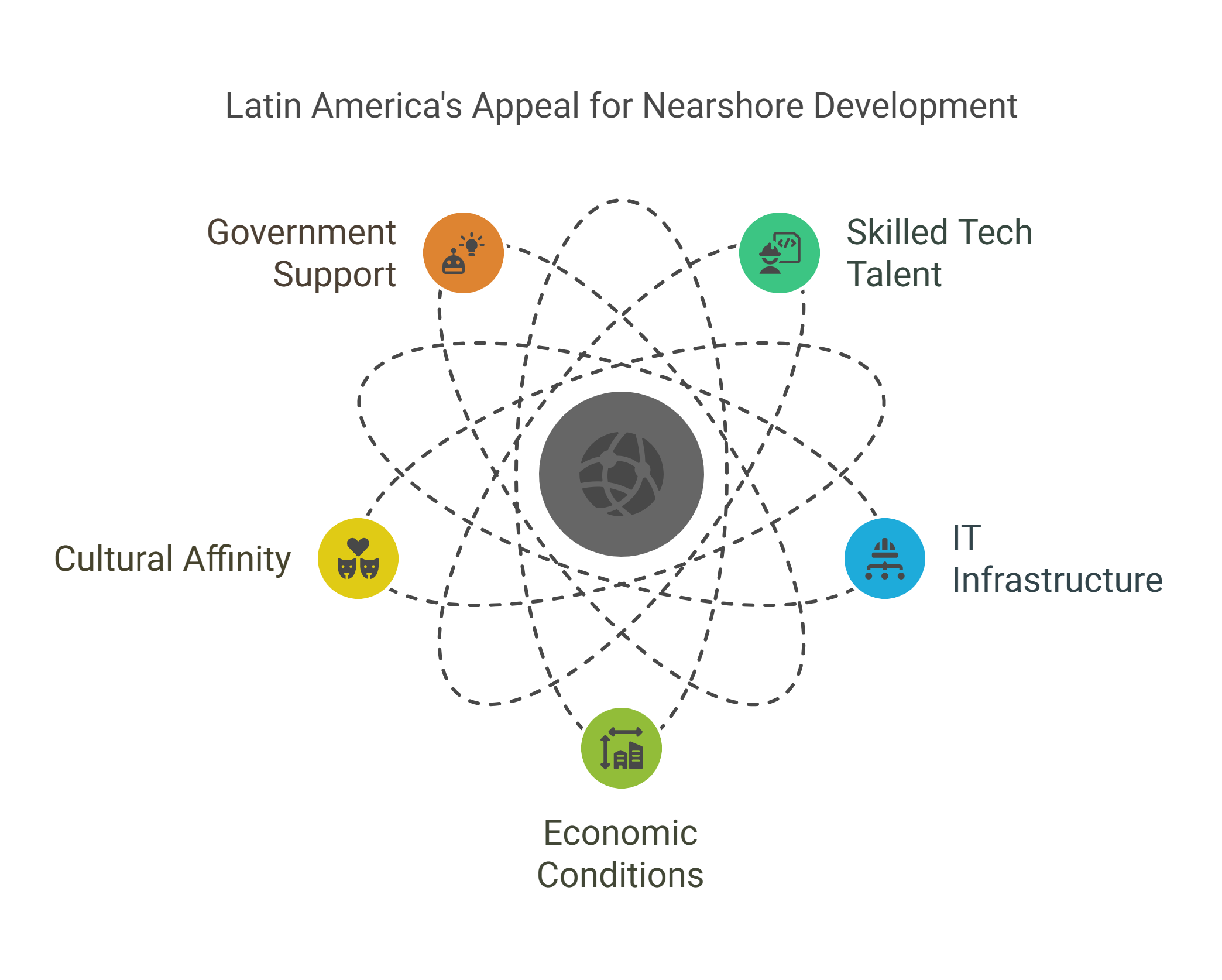Finding that sweet spot between cost, top talent, and smooth teamwork is a big deal in software development right now. Lots of businesses are looking at nearshoring as a solution to grab skilled developers, keep quality high, and make collaboration easy—all while keeping costs sensible. Let’s unpack what working with a development nearshoring company involves, covering the upsides, potential bumps, and how to pick the best partner for your project. 🤝
Simply put, a development nearshoring company provides software development services from a nearby country, typically within a 1-4 hour time zone difference. Think of it as outsourcing, but closer to home! Instead of sending work halfway across the planet (offshoring), you partner with teams in neighboring countries. This geographical closeness is key.
The main idea behind nearshoring is keeping things aligned. You get the benefits of accessing a wider talent pool without the major time zone headaches or cultural disconnects that can sometimes happen with offshore teams. It’s about finding that balance: cost savings meet easy collaboration. Proximity makes communication, travel (if needed), and overall project management much simpler.
“Nearshoring allows companies to enjoy highly skilled talent while enabling real-time collaboration due to minimal time zone differences.” – Keeper Solutions
One huge plus is tapping into a bigger pool of skilled developers. Nearshore locations often boast tech hubs brimming with professionals experienced in cutting-edge areas like Artificial Intelligence (AI), Machine Learning (ML), blockchain, and complex cloud architectures. This means you can find the exact expertise needed for your project, even if it’s hard to find locally. 👩💻👨💻
Let’s talk money! 💰 Nearshoring generally offers significant cost savings compared to hiring developers in-house in high-cost regions like North America or Western Europe. While maybe not as cheap as some offshore options, the rates are very competitive, and you avoid many hidden costs associated with managing teams across vast time differences. It’s a smart way to optimize your development budget without sacrificing quality.
Productivity often gets a nice boost too. Working with teams in similar time zones means real-time communication is straightforward. Problems get solved faster, feedback loops are quicker, and everyone feels more connected. Cultural similarities also play a role, reducing misunderstandings and making teamwork feel more natural and efficient. Shared work hours mean your teams can actually collaborate, not just hand off tasks.
“Countries like Colombia and Mexico offer skilled developers with strong English proficiency and competitive rates, ensuring high-quality outcomes.” – Leanware
So, how does nearshoring stack up against the other models? Onshoring means hiring developers within your own country. This offers maximum alignment and communication ease, but usually comes with the highest costs. Offshoring involves outsourcing to distant countries, often providing the lowest hourly rates but potentially bringing challenges with time zones, communication gaps, and cultural differences.
Nearshoring sits comfortably in the middle. It provides a cost advantage over onshoring while mitigating many of the collaboration difficulties found in offshoring. You get access to skilled talent at competitive rates, combined with the benefit of teams working during similar business hours. This makes coordination, agile development practices, and quick responses much easier to manage. ⏰

Think about project efficiency. With nearshoring, a quick video call to resolve an urgent issue is simple because everyone is likely working at the same time. With offshoring, that same issue might wait 12 hours for a response, potentially delaying the entire project. Geographic proximity and cultural affinity in nearshoring reduce friction and improve the overall flow of development work.
“Nearshoring eliminates the risks of miscommunication and delays, significantly improving project timelines.” – Waverley Software
Development nearshoring companies offer a wide array of services to cover pretty much any software need. Core offerings usually include custom software development, building web applications from scratch, mobile app development for iOS and Android, and increasingly, cloud computing services like migration, management, and optimization.
Beyond coding, many nearshore partners provide comprehensive support throughout the entire project lifecycle. This can cover everything from initial brainstorming and requirements gathering (conceptualization) to user interface (UI) and user experience (UX) design, rigorous quality assurance (QA) testing, deployment, and ongoing maintenance and support post-launch. It’s often a full-package deal. 📦
What really makes these companies valuable is their ability to provide solutions crafted for your business needs. Instead of just generic coding, they focus on understanding your specific challenges and goals to build software that delivers real business value. Whether it’s automating a process, reaching new customers via an app, or scaling infrastructure, the aim is purpose-built software.
“Nearshore companies specialize in creating tailored software solutions that address specific business challenges and requirements.” – Hire with Near
While nearshoring has many advantages, it’s good to be aware of potential challenges. Costs, while lower than onshoring, might be slightly higher than some offshore locations. It’s about balancing cost with the benefits of proximity and collaboration. You’ll need to weigh what’s most important for your project’s success.
There can also be legal and regulatory differences between countries to consider, especially around data privacy and intellectual property. Thoroughly vetting your potential nearshoring partner is essential. Make sure they have strong security practices, understand compliance needs, and have a solid track record. Integrating a nearshore team smoothly with your existing in-house staff also requires clear communication and defined processes. 👍
Selecting the right partner is key. Start by clearly defining your project scope, technical requirements, and business goals. Then, evaluate potential nearshoring companies based on their technical expertise, industry experience, and portfolio of past projects. Look for proof that they’ve successfully delivered projects similar to yours. Check client testimonials and case studies. 🧐
Assess the cultural fit and time zone alignment. How well do their communication styles match yours? Are they truly within a convenient time zone for collaboration? Evaluate their English proficiency and communication protocols. Smooth communication is the bedrock of a successful partnership. Ask about their development methodologies (e.g., Agile, Scrum) and project management tools.
.png)
Finding vetted, high-quality nearshore teams can feel overwhelming, but platforms like Nearshorely can simplify the process. They connect businesses with top-tier development talent in nearshore locations, helping you find partners that match your technical needs, budget, and company culture. Using such resources can save you time and give you confidence in your choice.
One of the standout benefits of nearshoring is the ability for teams to collaborate in real-time. When your external development team is only an hour or two away in terms of time zones, scheduling meetings, asking quick questions, and working together on complex problems becomes much simpler compared to coordinating across drastically different schedules. ⚡️
This time zone overlap directly boosts productivity. Feedback cycles are shorter, meaning adjustments can be made faster. Pair programming or joint debugging sessions are feasible. Your nearshore team feels more like an extension of your in-house team, leading to better integration, shared understanding, and faster progress towards project milestones. It fosters a more cohesive and responsive development process.
For companies based in North America, Latin America has become a major hub for nearshore software development. Countries like Mexico, Colombia, Brazil, Argentina, and Costa Rica are popular choices. They offer a strong combination of skilled tech talent, growing IT infrastructure, and favorable economic conditions. 🌎
These regions stand out for several reasons. They have a large pool of university-educated engineers and developers, many with strong English language skills. Cultural affinity with North America often makes collaboration smoother. Governments in these countries frequently support the tech industry, fostering innovation and providing a stable environment for outsourcing partnerships.

What is nearshore software development?
Nearshore software development is outsourcing software projects to companies located in nearby countries, typically sharing similar time zones (within 1-4 hours difference). It aims to balance cost savings with ease of collaboration and cultural alignment. For more details, see our FAQ.
How is nearshoring better than offshoring?
Nearshoring often provides advantages over offshoring through better time zone alignment, which allows for real-time communication and collaboration. Cultural similarities can also reduce misunderstandings. While offshoring might sometimes offer lower costs, nearshoring usually leads to smoother project management and potentially faster delivery due to reduced communication friction.
Which countries are the best for nearshore development?
For North American businesses, top nearshoring destinations are often found in Latin America, including Mexico, Colombia, Costa Rica, Brazil, and Argentina. These countries offer strong tech talent pools, competitive costs, and good cultural/time zone compatibility.
What services do nearshore companies typically offer?
Nearshore development companies typically offer a wide range of services, such as custom software development, web and mobile app development, cloud services, UI/UX design, quality assurance testing, and ongoing maintenance and support. Many provide end-to-end project handling.
How do I choose the right nearshoring partner?
To choose the right partner, define your needs clearly. Evaluate potential companies based on their technical skills, experience with similar projects, client reviews, and cultural fit. Check their communication practices and time zone alignment. Platforms like Nearshorely can help by connecting you with pre-vetted nearshore development teams that fit your requirements.
Working with a development nearshoring company offers a compelling mix of benefits: access to specialized talent, cost efficiencies compared to hiring locally, and improved collaboration thanks to geographic and cultural proximity. It bridges the gap between expensive onshore options and potentially complex offshore arrangements, providing a practical path for businesses needing high-quality software development. ✅
If you’re looking to scale your development capabilities, improve project outcomes, or simply get more value from your budget, nearshoring is definitely worth considering. Explore platforms like Nearshorely to discover skilled development teams in prime nearshore locations, ready to help you achieve your business objectives with expertly crafted software solutions.
Key takeaways: